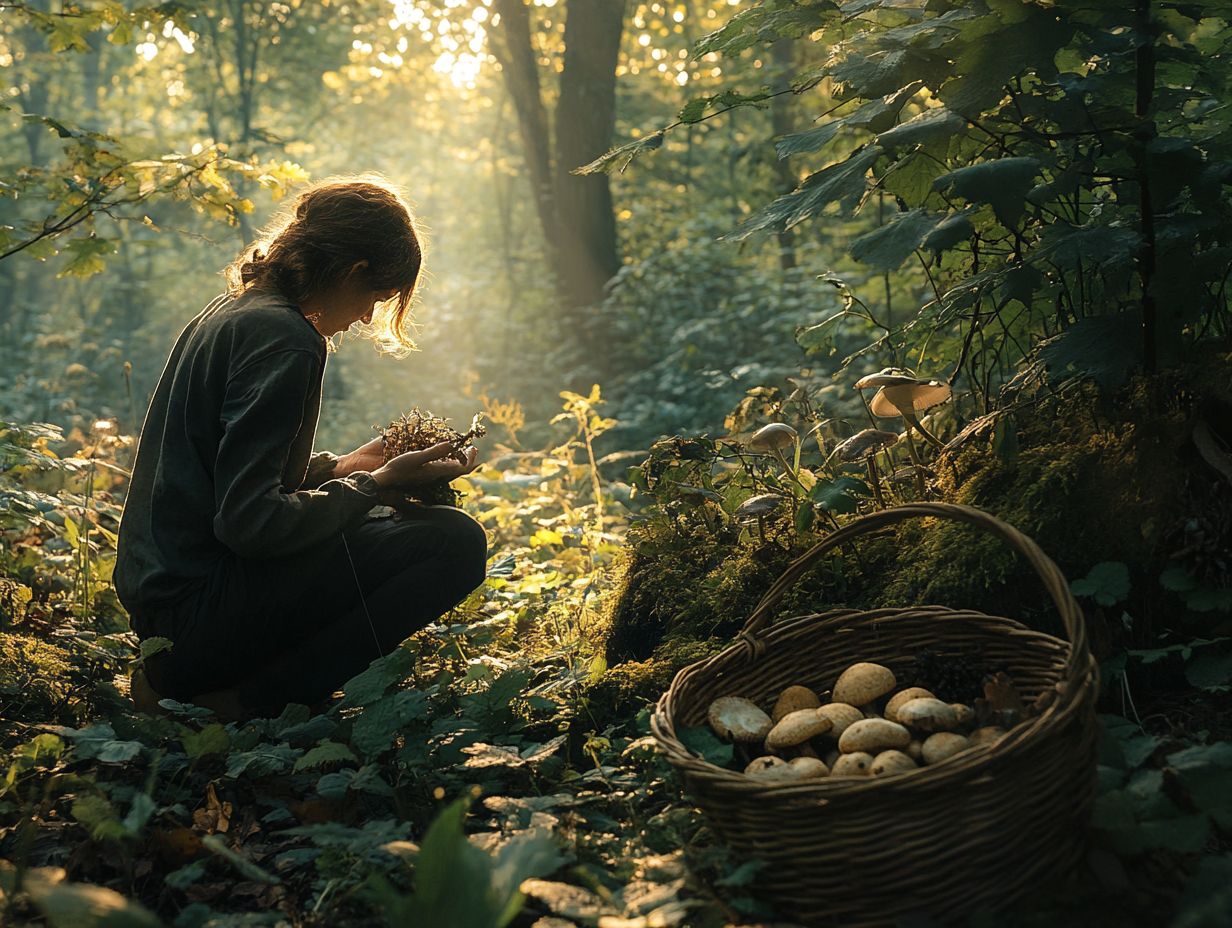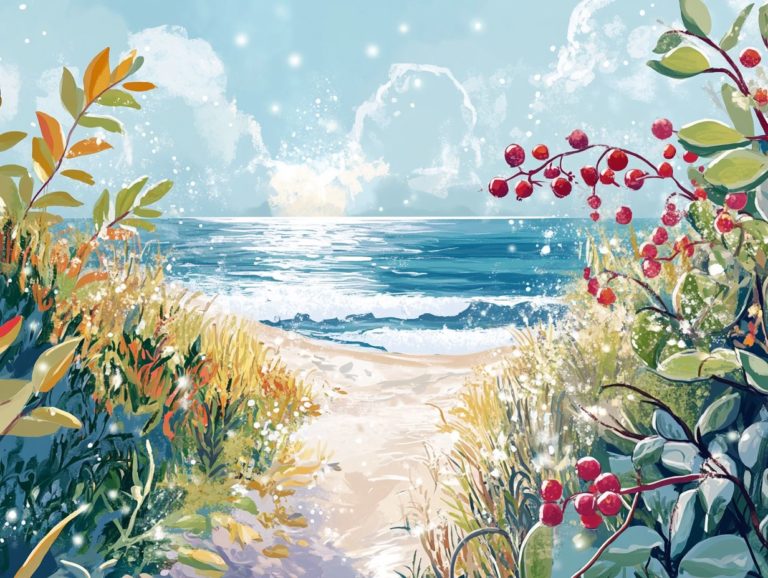What Should Beginners Know About Foraging?
Foraging offers a unique and fulfilling opportunity to connect with nature through outdoor activities. Explore new flavors and elevate your culinary experience with seasonal produce.
This article delves into the essential principles of foraging, highlighting both its nutritional and environmental advantages. You will learn the health benefits of gathering food from the natural environment and how to safely identify edible plants while steering clear of their poisonous counterparts.
Discover essential tools and foraging equipment that can enhance your adventures. Learn about the importance of ethical practices and regulations.
Whether you’re a beginner forager or just embarking on this journey, there s valuable insight here for everyone!
Contents
- Key Takeaways:
- Benefits of Foraging
- Foraging Safety
- Foraging Tools and Equipment
- Foraging Ethics and Regulations
- Frequently Asked Questions
- What Should Beginners Know About Foraging and Identifying Plants?
- What are Some Basic Safety Tips for Foraging and Foraging Ethics?
- Where Can Beginners Find Information About Foraging Laws and Regulations and Food for Free?
- What are Some Common Mistakes That Beginners Make When Foraging and Foraging Tips?
- Is it safe to eat anything I find while foraging, including wild seeds?
- Are there any resources or classes available for beginners interested in foraging and guided foraging?
- What are some sustainable foraging practices that beginners should know about, including cooking with nettles and spring salad?
Key Takeaways:

- Foraging is the act of gathering wild plants and food for consumption. It has numerous nutritional and environmental benefits for beginners to discover.
- Safety is crucial when foraging. Beginners should learn to identify and avoid poisonous plants and always carry the necessary tools and equipment for a successful foraging trip.
- Practicing responsible foraging ethics and following regulations is essential for preserving the environment and ensuring the sustainability of foraging for future generations.
What is Foraging?
Foraging is the art of seeking, gathering, and harvesting wild food from the natural world. It invites you to explore a diverse array of edible plants, fruits, nuts, and mushrooms available throughout the seasons. This age-old practice fosters a profound connection with nature and encourages living in a way that protects the environment.
Whether you’re identifying wild garlic, nettles, and elderflowers in spring or gathering blackberries, sweet chestnuts, and wild mushrooms in autumn, foraging is like embarking on a delicious treasure hunt in nature!
Historically, foraging was vital for survival, as early humans depended on wild foods for nourishment long before agriculture took root. Today, this timeless practice is enjoying a renaissance, especially within communities that prioritize local, organic ingredients and embrace the concept of a seasonal wild supermarket.
The advantages of foraging extend beyond just physical health; it deepens your connection to the environment, encouraging appreciation for the variety of living things in an area and the rhythms of the seasons. Engaging in outdoor activities like foraging promotes a healthier lifestyle and cultivates sustainable relationships with the land, making it a fulfilling family activity that more individuals and communities are enthusiastically adopting.
Benefits of Foraging
The benefits of foraging go well beyond collecting food; they weave together nutritional, environmental, and social dimensions, creating a truly enriching experience for individuals and communities.
When you engage in sustainable foraging practices, you connect deeply with your local ecosystem and contribute to the preservation of wildlife and the promotion of biodiversity. By selecting native plants that flourish in your surroundings, you can enjoy the health advantages of fresh, organic wild food while nurturing your relationship with nature.
Ready to dive into the world of foraging? Grab your basket and start your adventure today!
Nutritional and Environmental Benefits
The nutritional benefits of foraging primarily come from the wild foods you consume, which often boast higher levels of vitamins, minerals, and antioxidants compared to their cultivated counterparts. This makes them an exceptional addition to your diet.
Edible plants like nettles, wild garlic, dandelion, and wild strawberry are not only nutrient-dense but also low in calories. These plants offer delectable options to elevate your spring salads and seasonal dishes, as well as cooking with nettles.
Take blackberries, for example; they are teeming with vitamin C, fiber, and anthocyanins, a type of antioxidant that is good for your health. All of these can enhance your immunity and support digestion.
Sweet chestnuts bring their own flair to the table with a unique blend of carbohydrates, essential fats, and minerals like potassium, all contributing to heart health.
Responsible foraging practices benefit both your nutrition and local ecosystems. By promoting biodiversity and minimizing the environmental footprint of food sourcing, you help preserve nature s delicate balance. Thoughtful harvesting ensures that habitats remain intact and thriving, securing the health of our environment for generations to come.
Foraging Safety

Safety is your top priority when foraging! Your ability to accurately identify edible plants while steering clear of their toxic counterparts can determine whether your experience results in a delightful harvest or a dangerous mistake.
As a beginner forager, make it a priority to learn about common poisonous plants and seek guidance from reputable sources or foraging guides. Additionally, understanding what wildlife to consider while foraging can further enhance your experience. Richard Mabey’s ‘Food for Free’ is an excellent resource that provides invaluable insights into safe foraging practices, enriching your journey into this rewarding pursuit.
Identifying and Avoiding Poisonous Plants
Successfully identifying and avoiding poisonous plants is an essential skill for any forager. Many edible plants have toxic look-alikes that can pose serious health risks. By utilizing resources like local foraging guides and educational materials, you can gain valuable tips to help distinguish safe edible species from harmful ones, ensuring your outdoor exploration is both safe and rewarding.
For example, you might mistake wild carrots (Daucus carota) for the highly toxic water hemlock (Cicuta maculata). This makes it crucial to pay close attention to specific characteristics like leaf structure, stem color, and flower patterns to effectively identify plants and avoid toxic counterparts. As a beginner, it s wise to start with well-known, easily recognizable edibles, such as dandelion greens or chickweed. Keeping a foraging journal to note your observations and experiences can also be incredibly beneficial.
Consulting with local experts or joining guided foraging groups can significantly enhance your knowledge and confidence through guided foraging experiences. This approach not only reduces the risk of misidentification but also promotes sustainable foraging practices, allowing you to enjoy nature s bounty responsibly.
Foraging Tools and Equipment
Equipping yourself with the right tools and equipment can elevate your foraging experience, transforming it into a more streamlined and enjoyable endeavor as you gather wild foods from local parks or natural settings.
To ensure your foraging journey is successful, consider essential items such as:
- a robust basket for collecting edible plants.
- a small knife or scissors for precise harvesting.
- a reliable plant identification guide to help you accurately recognize the species you encounter along the way.
Grab your basket and head outside to discover nature s hidden treasures!
Essential Items for Successful Foraging
Essential items for your successful foraging adventures include a reliable wild food guide, the right collecting tools, and suitable containers to gather the treasures of nature’s seasonal bounty. A well-crafted foraging guide offers detailed insights on identifying local edible plants alongside practical tips for sustainable foraging practices that honor the ecosystem.
In addition to these resources, a sturdy pair of gloves protects your hands from prickly or potentially toxic plants. A small trowel is invaluable for gently unearthing roots or tubers without disturbing the surrounding plants. Opt for a basket or mesh bag to ensure proper air circulation, minimizing the risk of spoilage. Practicing responsible foraging means taking only what you need, allowing plant populations to flourish for future harvests.
By adhering to these guidelines, discover the exciting rewards that nature offers while playing an active role in the conservation of its habitats.
Foraging Ethics and Regulations

Grasping foraging ethics and regulations is essential for anyone eager to explore the wild in search of wild food. These guidelines foster a deep respect for nature and help preserve wildlife and the ecosystem for generations to come.
Embracing responsible foraging practices means familiarizing yourself with local laws about collecting, understanding the implications of invasive species (non-native plants that can harm the ecosystem), and appreciating the significance of sustainable methods that enhance ecosystem health.
Responsible Foraging Practices
Responsible foraging practices are essential for ensuring that your collecting activities do not harm native plants or disrupt the ecosystem, all while supporting the sustainable use of wild food resources. Prioritizing methods that preserve nature is key this means avoiding overharvesting, respecting wildlife habitats, and adhering to ‘leave no trace’ principles, which entail minimizing your impact on the environment during your outdoor adventures.
You can adopt specific strategies, such as familiarizing yourself with local regulations and foraging laws and joining community foraging groups and classes that promote shared knowledge and experience. This approach enhances your personal growth through outdoor exploration and gathering food while deepening your understanding of native plants and ensuring that your foraging activities are informed and environmentally conscious.
Embracing a mindset of stewardship and sustainable foraging practices, where you actively monitor the health of the ecosystems you explore, encourages more mindful practices. Engaging with local communities amplifies conservation efforts and preserves wildlife, fostering a shared responsibility for the land it’s an investment in the present and future that benefits everyone.
Frequently Asked Questions
What Should Beginners Know About Foraging and Identifying Plants?
Foraging refers to gathering wild food sources from nature. If you’re new to this practice, you might wonder what the best resources for local foraging are. Here are some frequently asked questions that beginners may have about foraging.
What are Some Basic Safety Tips for Foraging and Foraging Ethics?

Before heading out to forage, it’s important to learn about potential hazards and safety precautions. Always bring a guidebook or knowledgeable companion, wear appropriate clothing and footwear, and be aware of what to know about seasonal foraging in your area, including poisonous plants and wildlife.
Where Can Beginners Find Information About Foraging Laws and Regulations and Food for Free?
Laws and regulations regarding foraging vary by region and can change over time. Research and understand local laws before foraging. You can find information from your local government or conservation agency, or by connecting with foraging communities online.
What are Some Common Mistakes That Beginners Make When Foraging and Foraging Tips?
Beginners may mistakenly identify and consume poisonous plants or disturb fragile ecosystems. It’s important to do thorough research, be cautious, and understand foraging ethics to avoid these mistakes.
Is it safe to eat anything I find while foraging, including wild seeds?
No, not everything found in nature is safe or edible. Always identify plants and mushrooms before eating them.
If you’re not sure, it’s best to avoid consuming anything that raises doubts.
Are there any resources or classes available for beginners interested in foraging and guided foraging?
Yes, many resources can help beginners learn about foraging. These include guidebooks, online communities, workshops, and local classes.
What are some sustainable foraging practices that beginners should know about, including cooking with nettles and spring salad?
Beginners should follow sustainable foraging practices to protect natural resources. It’s important to know what to look for when foraging, only taking what you need and leaving some behind for wildlife and future foragers.
Avoid damaging or disturbing natural habitats during your foraging activities.






